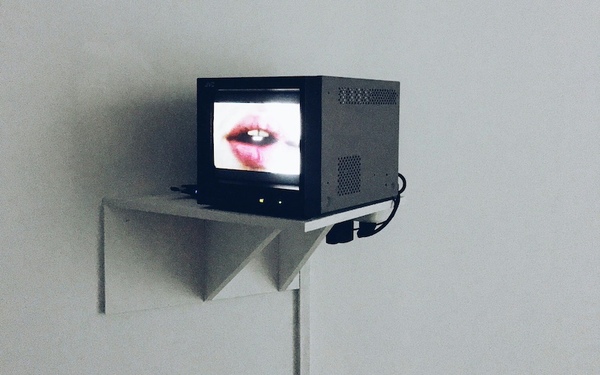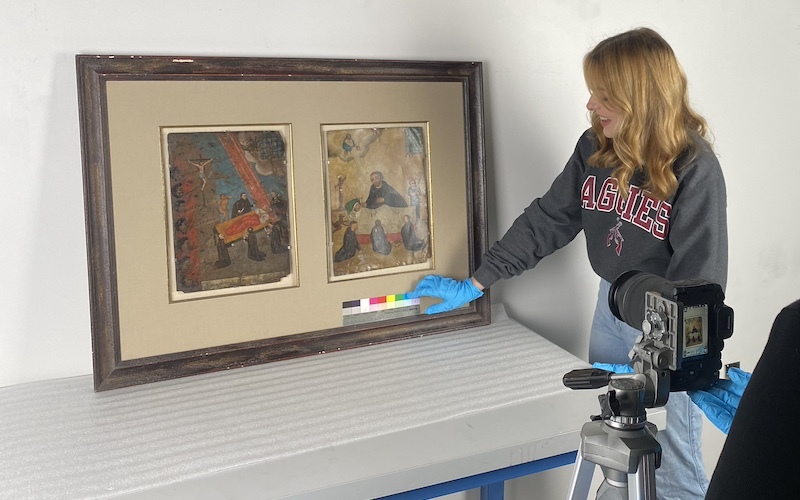 Students work together to photograph works from the NMSU University Art Museum's retablo collection. Image courtesy of New Mexico State University Art Museum
Students work together to photograph works from the NMSU University Art Museum's retablo collection. Image courtesy of New Mexico State University Art Museum
Campus art collections are evolving from display spaces into valuable educational resources for students across disciplines.
Once seen as static galleries reserved for specialized art majors or visitors, art collections have become dynamic educational tools that empower students across disciplines.
With the growing digitization of academic art collections, students now have unprecedented access to works of art that were once confined to the walls of galleries or nestled away deep in storage.
This digital transformation is reshaping how students engage with art, allowing them not only to explore and analyze pieces from anywhere but also to participate in hands-on learning experiences that deepen their understanding of art's impact on culture, history, and society.
For students pursuing careers in the arts, these experiences are invaluable. For those entering fields outside the arts, exposure to the arts can foster critical thinking, creativity, and interdisciplinary knowledge—skills that are increasingly helpful in today’s fast-changing job market.
Artwork Archive has the privilege of working with colleges and universities around the country and we’ve witnessed the different ways they are providing access to their collections and archives.
For instance, Davidson College’s Van Every/Smith Galleries forge unforgettable connections between their art and students. Art becomes a teaching tool. They have a number of work study positions; many of which are held by non-art majors. The undergraduates install exhibitions, write labels, photograph objects, research objects for social media, and update the Galleries’ Artwork Archive account.
Their ArtMate program, an art lending program for students, also expands the reach and impact of art for students across disciplines.
Keep reading for examples you can implement at your school.
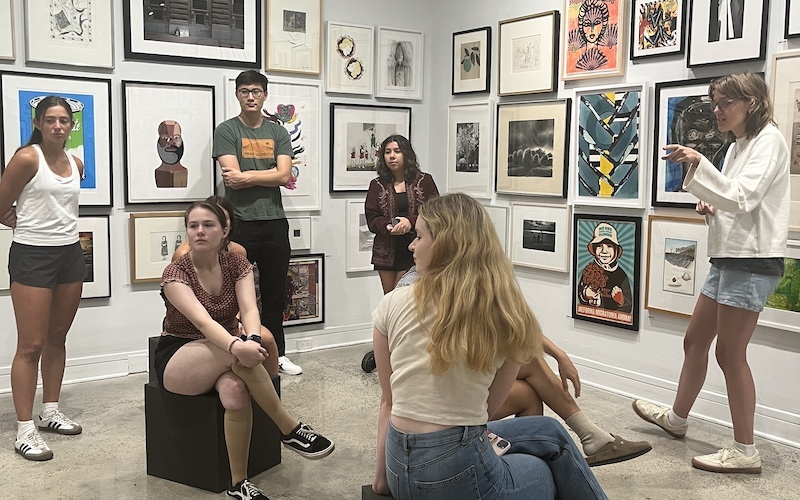 Students at Davidson College in a gallery displaying works available for their ArtMate program. Image courtesy of the Van Every/Smith Galleries. Read more about ArtMate.
Students at Davidson College in a gallery displaying works available for their ArtMate program. Image courtesy of the Van Every/Smith Galleries. Read more about ArtMate.
Give students ownership of a collection project
A large project for the Van Every/Smith Galleries is keywording the objects in their collection. Within the Galleries’ Artwork Archive account students assign Tags to artworks. The keywords cover basics like colors, style, what the art depicts, etc., and help organize the collection and make searching it more accessible–both on the backend and with their public view.
The Galleries staff created a handbook and a sheet for “how to write keywords.” The students follow along and practice the art of visual analysis.
Sarah is in her fourth year working at the Galleries and she shares that she’s used Artwork Archive since day one. “Part of our introduction to the collection is going into Artwork Archive and adding keywords. We’re exposed to the collection and Artwork Archive is a part of that.”
Provide your students with more entry points into your collection.
Sarah speaks to the importance of the keywording project: “We’re only as good as our keywords. A lot of classes at Davidson use our collection and our website; keywords can help engagement. We want students to be able to look up anything and have artworks pop up.
The keywords have also helped students when curating exhibitions. They are able to explore themes and artworks that fit within the scope. Students like Sarah use Artwork Archive to curate works around campus: “It’s a helpful tool for organizing the process.”
Students at Davidson also write articles about objects for their blog. Students are encouraged to search the Artwork Archive database to find something that piques their interest.
Izzy, an environmental studies major at Davidson, shares her personal connection to the collection thanks to the keywords: “Because of Artwork Archive, it’s easy for students to go to a collection of artworks and find art that is relatable to them. It’s easy for me to connect to the art if I go to Artwork Archive and click into the Environmental Studies collection tab or Africana studies or Architecture.”
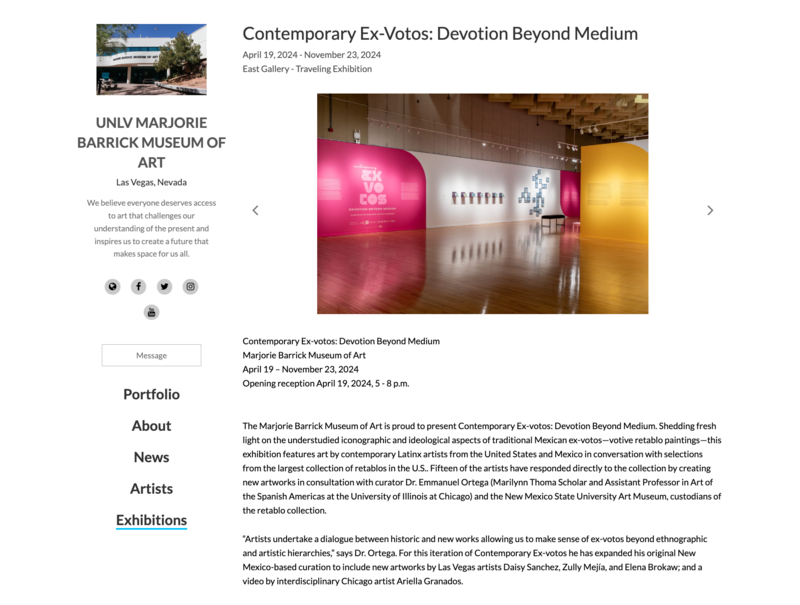 Screenshot from UNLV Marjorie Barrick Museum of Art's online exhibition "Contemporary Ex-Votos: Devotion Beyond Museum", a loaned exhibit from NMSU, hosted on their Artwork Archive Public Profile.
Screenshot from UNLV Marjorie Barrick Museum of Art's online exhibition "Contemporary Ex-Votos: Devotion Beyond Museum", a loaned exhibit from NMSU, hosted on their Artwork Archive Public Profile.
Allow students to access content online, offering more flexibility than being on-site.
The shift to online access offers students new opportunities to engage with art in meaningful ways, whether they are analyzing a painting for a class project, conducting research for a thesis, or simply exploring an exhibition.
The Marjorie Barrick Museum of Art at UNLV shared that bringing their exhibitions online made the museum more welcoming to students. Some students may be unfamiliar with museums and wary of entering, the online exhibition gives them an introduction and a way to become more comfortable before entering the gallery.
Web access supports community college students as well. Most are commuters and may not have the availability to view an artwork or exhibition in person for a class or project.
Online research also takes a load off of your museum staff and your objects. You can provide scholarly information without pulling an object out of storage (if that’s your wish).
Gaby, a senior psychology major, created a library guide in collaboration with the campus library about the public art on campus. “I use Artwork Archive to find pieces in our collection that I want to write about. It is a great resource to see the object virtually when I don’t have the opportunity to be on site.”
Bring the art outside of the museum
Oliver, an economics and political science double major at Davidson, astutely says:
“Often the art collection can be hidden on campus. Online access lets students know it’s there. And that the artworks in the galleries aren't the only ones. There's a whole world of artwork that they don’t know about. Having our collection online provides visibility and generates interest.”
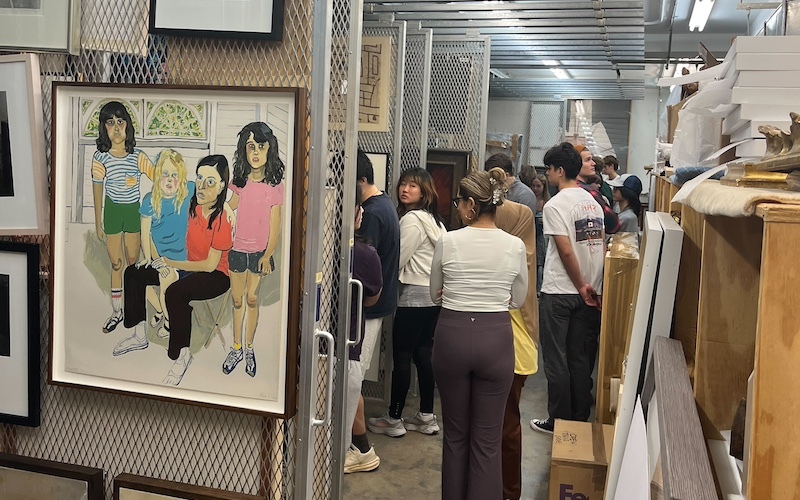 Davidson College students in the collections' storage. Image courtesy of the Van Every/Smith Galleries.
Davidson College students in the collections' storage. Image courtesy of the Van Every/Smith Galleries.
Give your students a hands-on introduction to collection management.
“I'm proud to be able to list my knowledge of Artwork Archive on my CV.”
Lauren, an undergraduate student at the University of Nevada, Las Vegas, gained collection management experience while working for the Marjorie Barrick Museum of Art. Since Artwork Archive is so easy to use, and cloud-based, she was able to quickly jump in and utilize the platform.
“Artwork Archive makes daily collections management tasks much easier and quicker than other programs I have used. The program is much easier to navigate than others my museum has used in the past; the layout is very user-friendly. As an academic museum, we have many undergraduate and graduate student workers come through, and this program is friendly enough that anyone can feel confident using it in no time.”
Students can drive your digitization projects
We’ve seen a number of academic institutions lean on their students for digitizing their collections. It’s a win/win. The students get the experience and the museum gets digitization support.
Olivia, a graduate assistant for the New Mexico State University Art Museum, helped digitize an entire collection of 2,000 Mexican retablos–the largest public collection of Mexican retablos in the United States.
Olivia worked with the museum’s collections manager for a year – creating new entries for the retablos and uploading conservation reports into their Artwork Archive account. She also worked alongside an undergraduate to photograph the objects and edit the images.
“I didn’t have any experience with digitization before the project; everything I learned from the process was new information. I gained a lot of skills that I can use later in my career, especially since many museums don’t have their collections fully digitized. I’m excited to have that on my resume and bring it with me. I want to keep working with museum collections.”
And now that the collection is digitized, the museum (and Olivia) can easily share information with others. “I just put together an inventory report of artworks for someone to preview before they come in to view our collections in person.” And Olivia will be curating a show for the Retablo gallery this spring using the data she entered into the museum’s Artwork Archive account.
The University Art Museum is excited to start working with students to start integrating audio descriptions of the objects. With the ability to include audio files in artwork records, the museum will be able to easily share informative audio descriptions.
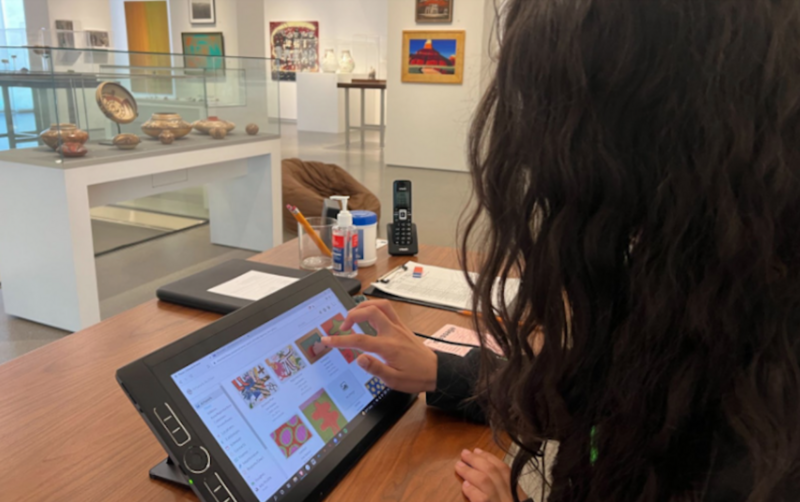 A student intern at the John & Geraldine Lilley Museum of Art at University Nevada, Reno, sitting in the gallery and updating their Artwork Archive database.
A student intern at the John & Geraldine Lilley Museum of Art at University Nevada, Reno, sitting in the gallery and updating their Artwork Archive database.
Develop resilient students who learn that mistakes are part of the process
In college, students struggle with perfectionism, as few areas allow for failure. Many of the Davidson students spoke about their appreciation for having a safe space to make mistakes within the Van Every/Smith Galleries.
Sarah shared: “We have the freedom to make mistakes and learn along the way. [They] put a lot of trust in us–to have such a level of trust at such a young age is remarkable.”
Sarah continues: “I used to find matting and framing difficult but I’m in such a supportive environment where it’s ok to make mistakes. Now I love to install.”
Your art collection can help shape career pathways for students
We learned that a number of undergraduate students were inspired by their art collection experience when considering career decisions.
Gaby, a psychology major that works with the Van Every/Smith Galleries wants to combine art with mental health.
Sarah, a senior at Davidson, initially was a political science major, but after her work study with the Van Every/Smith Galleries, she switched to art history. “I want to work at a museum. I’m writing my thesis about museum work. It’s put me on a whole new trajectory.”
Izzy, an environmental science major at Davidson, had the unique opportunity to work with a visiting artist, Nicholas Galanin, on his collaboration with the Catawba Indian Nation. The project involved biology, environmental studies and history and culminated in the exhibition Unshadowed Land. And the project made an impact on Izzy: “My connection to the gallery and being introduced through the collaboration with the Nation made me interested in doing more social science work.”
Oliver, an economics and political Science double major, has worked with the Van Every/Smith Gallery for four years either writing blog posts or curating artworks on campus. Oliver plans to go into data analytics or consulting, but he’ll take his experience with the galleries with him.
Oliver shares: “I love art. I’m not good at making it. But, I want to be around it.”
Artwork Archive is honored to help academic institutions provide students with access to valuable collection resources—whether for research or creative inspiration. We’ve witnessed colleges and universities utilize the arts to nurture a generation of curious, creative thinkers and active participants in culture and society, and we can't wait to see how they help shape the future.




